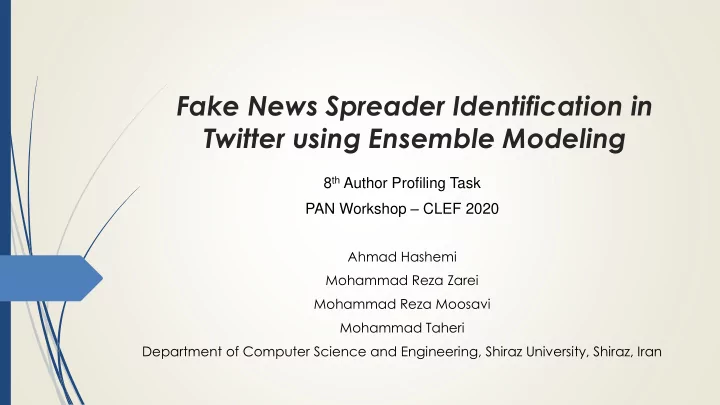

Fake News Spreader Identification in Twitter using Ensemble Modeling 8 th Author Profiling Task PAN Workshop – CLEF 2020 Ahmad Hashemi Mohammad Reza Zarei Mohammad Reza Moosavi Mohammad Taheri Department of Computer Science and Engineering, Shiraz University, Shiraz, Iran
Introduction Why Study Fake News? 2/16 Negative consequences of fake news propagation Political Aspects Economic Aspects Health Related Aspects
Introduction 3/16 Profiling Fake News Spreaders Hypothesis: Users who do not spread fake news have a set of different characteristics compared to users who tend to share fake news. Identifying fake news spreaders as a first step towards fake news detection
Dataset The PAN-AP-20 Provided Corpus 4/16 Number of authors in the competition dataset: Language Training Test Total English 300 200 500 Spanish 300 200 500 For each author, their last 100 tweets have been retrieved
Methodology Overview of The Proposed Model 5/16
Methodology Statistical features 6/16 Fraction of retweets (tweets starting with "RT") Average number of mentions per tweet Average number of URLs per tweet Average number of hashtags per tweet Average tweet length
Methodology Implicit Features 7/16 Age (English dataset) Gender (English dataset) Emotional Signals English dataset: anger, anticipation, disgust, fear, joy, sadness, surprise, trust Spanish dataset: joy, anger, fear, repulsion, surprise, sadness Personality (English dataset) Agreeableness, conscientiousness, extraversion, neuroticism, openness
Methodology Word Embeddings 8/16 Preproccessing Omitting retweet tags, hashtags, URLs and user tag TweetTokenizer module from the NLTK package English dataset: pretrained on blogs, news and comments Spanish dataset: pretrained on news and media contents
Methodology Term Frequency – Inverse Document 9/16 Frequency (TF-IDF) Preproccessing Eliminating punctuations, numbers and stop words Stemming Omit-ting retweet tags, hashtags, URLs and user tag TweetTokenizer module from the NLTK package
Methodology 10/16 Ensembling the Models Use soft classifiers to obtain the confidence of each model c i ( u ) c out ( u ) = αc 1 ( u )+ βc 2 ( u )+ γc 3 ( u ) α + β + γ = 1 c 1 ( u ): confidence of the classifier for TFIDF features c 2 (u): confidence of the classifier for Word Embeddings features c 3 (u): confidence of the classifier for implicit+statistical features The label of the user u is determined as:
Experimental Result 11/16 Model Selection Accuracy scores of 10-fold cross-validation Feature groups Dataset SVM Random Logistic Forest Regression Statistical + Implicit English 57.6 69 49.6 TF-IDF English 68.3 70.3 68.3 Embedding English 67.6 71.3 67.6 Statistical + Implicit Spanish 72.6 73 56 TF-IDF Spanish 82 80 81.6 Embedding Spanish 74 76.3 76
Experimental Result 12/16 Ensembling the Models Determined weight parameters for merging the individual classifiers Language TF-IDF ( α ) Embeddings( β ) Statistical+Implicit ( γ ) English 0.15 0.45 0.4 Spanish 0.65 0.1 0.25
Experimental Result Local Evaluation 13/16 10 fold cross validation scores obtained on different components Features Accuracy (en) Accuracy (es) TF-IDF 70.3 82 Embedding 71.3 76.3 Statistical + Explicit 69 73 Ensembled model 74.6 82.9 (final model)
Experimental Result Final Results 14/16 Accuracy scores obtained on the local evaluation and the official test set Language Cross-validation Official test set English 74.6 69.5 Spanish 82.9 78.5 Average 78.75 74.0
Future Work 15/16 Extracting more Implicit features and analyzing their discrimination Proposing a learning scheme for the ensemble unit Using the fake news spreader identification results for fake news detection
Thank You For Your Attention! s.ahmad.hmi@gmail.com mr.zarei@cse.shirazu.ac.ir
Recommend
More recommend